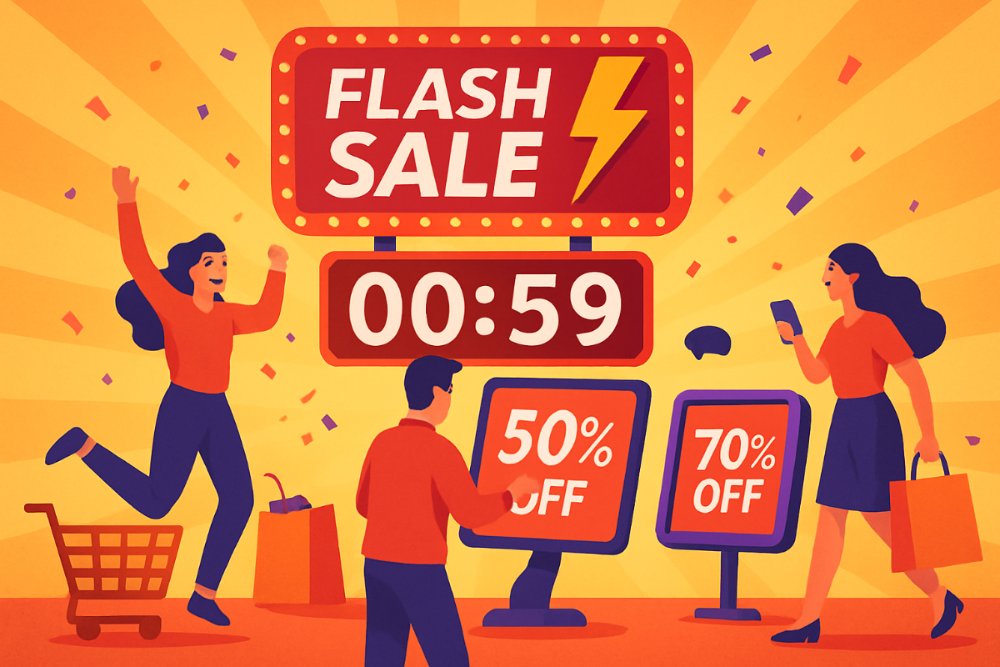Flash sales are a powerful tool for direct-to-consumer (DTC) e-commerce brands looking to boost sales and create excitement among customers. However, executing a successful flash-sale campaign requires more than just slashing prices. It involves strategic planning and effective communication to ensure maximum impact. In this guide, we’ll delve into the essential elements of crafting a flash-sale campaign, from planning to execution, and cover the best practices to optimize your sales and customer satisfaction.

1. Understanding Flash Sales
A flash sale is a time-limited discount event that creates urgency and excitement among customers. Unlike regular sales, these are brief, often lasting only a few hours to a day, encouraging swift decision-making from consumers. This time constraint persuades potential buyers to act quickly, often leading to impulsive purchases. For DTC brands, it’s not just about selling quickly but also fostering customer loyalty and engagement by providing perceived high-value offers and exclusive deals.
2. Setting Clear Objectives
Before you launch a flash-sale campaign, establish clear objectives. Are you aiming to clear out old inventory, acquire new customers, or increase short-term revenue? Defining your goals will guide your marketing strategies and help measure the success of your sale. Clear objectives allow you to tailor your messaging and promotional tactics to align with your brand's long-term objectives while ensuring that each sale serves a purpose beyond just immediate financial gain.
3. Planning and Execution
A successful flash sale requires meticulous planning. Start by setting a budget, choosing products to feature, and deciding on the discount percentage. Use data analytics to identify best-selling products or inventory that needs movement. Plan the timing strategically, avoiding major holidays unless it ties into a larger theme. Ensure your website can handle increased traffic and provide a seamless customer experience. Implement countdown timers and strategic pop-ups to keep the urgency and excitement alive during the sale.
4. Crafting an Enticing Offer
The heart of any flash sale is the offer itself. Create irresistible deals by carefully selecting products that are popular, yet profitable. Bundling products or offering special editions exclusive to the sale can increase average order value and customer satisfaction. Price discounts should be steep enough to catch attention but sustainable for your profit margins. Consider adding free shipping or limited-time rewards for purchases to further entice buyers and enhance the overall offer.
5. Timing is Key
The success of a flash sale can hinge on timing. Analyze your customer data to find when your audience is most active online. Weekends or evenings might work best, depending on your target demographics. Avoid overlapping with competitors’ sales to capture undivided attention. Announce your sale ahead of time through teasers or secret deals to build anticipation. Align the sale with special occasions or seasons to make more sense contextually and increase relevance for potential buyers.
6. Leverage Email Marketing
Email marketing is a powerful tool for promoting your flash sale. Craft compelling, urgency-driven subject lines and personalized messages tailored to your customer segments. Send pre-sale teasers, launch announcements, and last-minute calls to action. Segment your email list to target the most engaged customers first, and time your emails strategically. Post-sale, follow up with gratitude messages and surveys to gather customer feedback and foster long-term loyalty.
7. Social Media Strategies
Social media provides a direct line to your audience, making it an ideal platform for flash-sale promotions. Use visually enticing graphics, videos, and countdowns to create buzz. Leverage stories, live streams, and influencer collaborations to reach a wider audience. Encourage engagement through contests, shares, and hashtags relevant to your brand. During the sale, keep followers updated with real-time stock levels and extend the excitement with exclusive social media-only offers.
8. Website Optimization
Your website is the front line of your flash-sale campaign; ensure it’s fully optimized for performance. Test its ability to handle potential traffic spikes and ensure ease of navigation. Implement features like a countdown timer for the sale’s duration and a progress bar showing how much is sold or available. A smooth checkout process is essential to minimize cart abandonment. Provide clear shipping, return policies, and customer support to address potential concerns swiftly.
9. Post-Sale Analysis
After the sale ends, thorough analysis is crucial for learning and future campaign improvements. Review sales data versus targets to understand what drove success or where you missed the mark. Analyzing customer behavior, engagement rates, and website traffic provides valuable insights. Conduct post-sale surveys and solicit customer feedback to identify areas for improvement. Use this information to refine future tactics and better understand how to serve your audience effectively.
10. Building Long-Term Customer Relationships
Flash sales shouldn’t just be a quick push for sales; they should also enhance customer relationships. Foster loyalty by delivering exceptional customer service and following up to thank customers for their purchases. Offer exclusive membership or early access benefits for loyal customers to maintain engagement. Turn first-time buyers into repeat customers by creating personalized follow-up content based on their interests. Building strong customer relationships increases the potential for long-term growth and repeated success in future campaigns.
Conclusion
With the right planning and execution, flash sales can significantly boost your DTC e-commerce business’s visibility, sales, and customer engagement. By maintaining a strategic approach throughout each phase—from planning and promotions to post-sale analysis—you can leverage flash sales as a dynamic tool to achieve both short-term wins and long-term growth. Always remember, the ultimate aim is to not only make sales but to build lasting relationships with your customers through value, engagement, and experience.